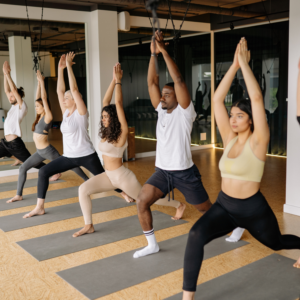Introduction to Walking as an Exercise
Walking is one of the most natural and accessible forms of physical activity that individuals of all ages can embrace. As a comprehensive exercise routine, walking offers a plethora of benefits that make it an ideal choice for those seeking to improve their overall health without the need for specialized equipment or extensive training. This inclusive form of exercise can be easily incorporated into daily life, making it suitable for a wide array of individuals, regardless of fitness level.
The low-impact nature of walking is one of its most significant advantages. Unlike high-intensity workouts that can be taxing on the joints, walking provides a gentle yet effective way to engage the muscles and enhance cardiovascular health. This characteristic makes it particularly appealing for older adults or individuals recovering from injuries, as it aids in maintaining mobility while minimizing the risk of strain or aggravation of existing conditions.
In addition to its accessibility and low-impact benefits, walking also has a positive impact on mental well-being. Numerous studies suggest that regular walking can help reduce stress, anxiety, and symptoms related to depression. The rhythmic nature of walking, combined with the opportunity to connect with nature or simply enjoy the surroundings, facilitates a state of mindfulness that can enhance emotional health.
Moreover, walking serves as an effective means to burn calories and manage weight. When integrated into a routine, it can contribute to significant health improvements, such as lowering the risk of chronic diseases like heart disease, diabetes, and hypertension. The versatility of walking allows individuals to tailor their pace and duration to suit their personal fitness goals, making it a functional exercise option that everyone can adopt to lead a healthier lifestyle.
Physical Health Benefits of Walking
Walking is one of the simplest yet most effective forms of exercise, offering numerous physical health benefits that contribute significantly to overall well-being. One of the primary advantages of walking is its positive impact on cardiovascular health. Regular walking has been shown to strengthen the heart, improve circulation, and reduce the risk of heart disease. According to a study published in the Journal of the American College of Cardiology, individuals who walked for at least 150 minutes per week experienced a substantial decrease in cardiovascular events.
Weight management is another significant benefit of incorporating walking into a daily routine. As a moderate-intensity exercise, walking helps burn calories and can aid in maintaining or losing weight. Research indicates that an average person burns approximately 100 calories per mile walked, making it an accessible option for those seeking to control their weight effectively.
Enhanced muscular strength is also a byproduct of walking, particularly in the lower body. Engaging in regular walks strengthens key muscle groups, including the quadriceps, hamstrings, and calves. This improvement in muscular strength contributes to better functional mobility and can assist in daily activities, thus enhancing quality of life.
Furthermore, walking plays a critical role in promoting joint flexibility and reducing stiffness. It encourages the production of synovial fluid, which lubricates joints and aids in their overall functionality. Studies have shown that individuals who regularly walk have lower rates of arthritis and related joint issues.
Given these benefits, it is clear that walking serves as a valuable exercise routine, promoting heart health, weight control, muscular strength, and joint flexibility. The myriad advantages underscore walking’s effectiveness and accessibility as a physical health booster for a diverse range of individuals.
Mental Health Benefits of Walking
Walking is increasingly recognized not only as a physical exercise but also as a powerful tool for enhancing mental health. Engaging in regular walking routines can significantly reduce stress levels, a benefit that has been substantiated by various studies. The simple act of moving outdoors, with the rhythmic sound of feet on the ground, can help quiet an overactive mind and promote relaxation. The release of endorphins during physical activity contributes to an overall sense of well-being, decreasing feelings of anxiety and tension.
Moreover, walking has been linked to significant improvements in mood. Evidence suggests that individuals who engage in regular walking report higher energy levels and greater life satisfaction. A study published in the Journal of Affective Disorders highlighted that participants who walked for just 30 minutes a day experienced a noticeable uplift in their mood and a reduction in symptoms of depression. This effect is often attributed to the combination of physical exertion and exposure to nature, which fosters a sense of connection and joy.
Cognitive function also benefits from regular walking. Research indicates that moderate physical activity can enhance brain health, improve memory, and boost overall cognitive capabilities. By increasing blood flow to the brain, walking aids in the release of various growth factors that help support neuron health. A comprehensive review in the journal Neuropsychobiology noted that participants who engaged in walking exercises demonstrated improved attention spans and quicker decision-making skills.
Additionally, many individuals report an increase in mental clarity after walking. The clarity that follows can be attributed not only to the reduction of anxiety but also to the meditative aspects of repetitive movement. Numerous testimonials highlight the ability to think more clearly after a walk, as the mind is often freed from distractions. Consequently, walking emerges as a simple yet effective strategy for fostering mental health. The multifaceted benefits of this activity underscore its viability as an essential component of a comprehensive well-being strategy.
Creating a Walking Routine
Establishing a successful walking routine involves several key components that contribute to both consistency and progress. To begin, it is essential to set realistic goals that are aligned with your fitness level and lifestyle. For instance, if you are new to exercise, aiming for a 15-20 minute walk a few times a week can serve as a solid starting point. As you grow more accustomed to walking, consider gradually increasing the duration and frequency of your walks.
Choosing the right environment is also crucial to enhancing your walking experience. Ideally, select a location that is safe, visually appealing, and conducive to walking. Parks, nature trails, and quiet neighborhoods are often ideal settings, providing not only a pleasant atmosphere but also the opportunity to connect with nature, which can further motivate you to stick with the routine. Furthermore, engaging in walks with a friend or group can promote accountability and enjoyment.
Scheduling your walks to fit into your daily life can significantly increase adherence to your walking routine. Consider incorporating your walks during times that traditionally feel free, such as early mornings, lunch breaks, or after dinner. By treating your walking schedule as an important appointment, you are more likely to prioritize it. Additionally, using technology, such as fitness apps or wearable devices, can help you track your progress, set reminders, and even create walking challenges with friends or family members.
To achieve better results and prevent plateauing, it is advisable to gradually increase both distance and intensity over time. You can implement variations such as interval walking, where you alternate between periods of brisk walking and moderate pace walking. This not only adds variety but also boosts cardiovascular fitness more effectively. Alongside these methods, remember to listen to your body and rest when necessary, ensuring that your walking routine remains sustainable and enjoyable.
Incorporating Variety: Different Walking Styles
Walking is a fundamental form of exercise that can be adapted to suit various fitness levels and goals. By incorporating different walking styles into your routine, you can enhance cardiovascular health, build muscle strength, and maintain engagement. Among the most popular walking modalities are brisk walking, power walking, and hiking.
Brisk walking is characterized by a speed that elevates the heart rate while still allowing for conversation. This moderate-intensity exercise can be easily integrated into daily routines, making it an excellent option for individuals looking to improve their overall fitness. Studies suggest that brisk walking can lower the risk of chronic diseases, increase stamina, and promote weight loss. To maximize benefits, aim for sessions of 30 minutes or more at a consistent pace.
Power walking, on the other hand, is a more vigorous form of walking that involves a faster pace and the use of arm movements to increase intensity. This style focuses not only on speed but also on improving muscle strength, particularly in the legs and core. Incorporating intervals of power walking into your exercise regimen can yield significant improvements in aerobic capacity and overall endurance. Using proper techniques, such as maintaining an upright posture and striking the ground with the midfoot, further enhances the effectiveness of this approach.
Hiking presents another dynamic option that offers diverse terrain and natural scenery, providing physical challenges along with mental stimulation. The inclines and varying surfaces encountered during hikes engage different muscle groups, promoting strength and flexibility. Hiking can also be a social activity, encouraging individuals to connect with friends or family while exercising. Exploring local trails not only improves cardiovascular fitness but also allows for relaxation and stress relief.
By embracing a variety of walking styles, you can create a balanced exercise routine that remains enjoyable and motivating. Mixing brisk walking, power walking, and hiking allows individuals to reap the unique benefits of each style while keeping workouts fresh and engaging. This variation ultimately contributes to a more sustainable and holistic approach to fitness.
Walking with Purpose: Adding Strength and Endurance Training
Walking is often perceived as a simple aerobic activity; however, it can be transformed into a comprehensive exercise routine when combined with strength and endurance training. Incorporating additional exercises during walking sessions not only enhances cardiovascular fitness but also boosts overall muscular strength and endurance. This multifaceted approach allows individuals to maximize the benefits derived from their walking workouts and promotes a balanced fitness regimen.
To infuse strength training into your walking routine, consider performing bodyweight exercises during brief intervals. For instance, every five to ten minutes of walking, take a moment to execute simple exercises like squats, lunges, or push-ups. These activities can engage various muscle groups, providing a full-body workout. Additionally, resistance bands can be easily integrated into your walking routine. These bands are versatile and portable, allowing you to perform bicep curls, lateral leg raises, or tricep extensions while still moving. This integration can lead to improved muscle tone, increased metabolic rate, and heightened walking efficiency.
Moreover, endurance training can be enhanced through interval walking or adding inclined surfaces to your routine. For example, alternating between brisk walking and a slower pace can improve cardiovascular strength and endurance. Using inclined pathways, staircases, or treadmills with adjustable hills can further augment the intensity of the workout. By mixing walking with strength-building exercises and endurance-accelerating techniques, participants can create a dynamic fitness experience that challenges their bodies in multiple ways.
This well-rounded approach to walking not only keeps the exercise engaging but also addresses diverse fitness goals. By committing to a routine that integrates strength and endurance training with walking, individuals can cultivate an effective and enjoyable exercise regimen that promotes long-term health and vitality.
The Social Aspect of Walking
Walking is not just a solitary activity; it can be a rewarding social experience that adds significant value to the routine. Engaging in walking with others fosters motivation and encouragement, making the activity more enjoyable. When individuals exercise alone, it can sometimes lead to a lack of commitment or boredom. However, walking with a friend or in a group can elevate the experience by introducing elements of companionship and shared goals.
One of the prime benefits of walking with others is the opportunity for social interaction. Conversations that occur during a walk can build camaraderie and strengthen relationships. Sharing stories or discussing everyday topics while on the move not only enhances social connections but can also provide a sense of fulfillment that solitary exercise cannot offer. Furthermore, the setting of common goals in a walking group can instill a sense of accountability, motivating individuals to adhere to their fitness plans and maintain consistency in their exercise routines.
To leverage these social benefits, forming walking clubs or finding walking partners can be highly effective. Interested individuals can start by reaching out to friends, family, or colleagues who express a desire to improve their fitness levels. Additionally, local community centers, gyms, or online platforms often provide resources to join existing walking groups. Leveraging social media platforms can also aid in promoting walking clubs where individuals can meet regularly and explore local paths together.
As one integrates walking into their exercise routine, embracing the social aspect can enhance personal health objectives while simultaneously fostering meaningful interactions. Whether walking for health benefits or social engagement, pairing up can make the journey toward fitness considerably more rewarding.
Overcoming Challenges and Staying Motivated
Maintaining a walking routine can be challenging due to various barriers that individuals may encounter. From time constraints to inclement weather and feelings of monotony, these obstacles can deter even the most enthusiastic walkers. Recognizing these challenges is the first step in developing effective strategies to overcome them.
One of the primary reasons individuals abandon their walking routines is a perceived lack of time. To combat this, one could incorporate walking into daily activities, such as opting for a walking commute or taking brief walks during lunch breaks. It can be beneficial to schedule walking sessions just like any other appointment, ensuring that the time dedicated to this exercise is prioritized. Additionally, exploring the option of shorter, more intense walking sessions can also yield substantial health benefits while fitting more conveniently into a busy schedule.
Weather conditions often serve as a significant deterrent for many aspiring walkers. To address this, individuals can consider investing in appropriate outdoor gear, such as waterproof jackets or sturdy footwear suited for various climates. Alternatively, seeking indoor walking venues, such as shopping malls or gyms, can provide shelter from harsh weather while still allowing individuals to stay active. Variety is key; walking in different environments or with a exercise group can break the routine and elevate the overall experience.
Boredom can creep into any exercise regimen over time. To counteract this, integrating music, podcasts, or audiobooks into the walking experience can significantly enhance enjoyment. Setting achievable goals and tracking progress can also yield motivation, making individuals feel accomplished and encouraged to continue their walking journey. Engaging with a community, whether through local walking clubs or online forums, can offer additional support and enthusiasm.
By proactively addressing these common challenges and employing motivational techniques, individuals can remain committed to their walking regimen, fostering a sustainable and rewarding exercise habit.
Conclusion: Embrace Walking for a Healthier Lifestyle
In the journey towards improved health and wellness, incorporating regular walking into your daily routine stands as an undeniably beneficial practice. Walking not only enhances physical fitness but also contributes significantly to mental well-being. As discussed throughout this guide, the key benefits of walking include its role in reducing the risk of chronic illnesses, improving cardiovascular health, and managing weight effectively. Additionally, walking can serve as a foundation for more extensive fitness ambitions, making it an ideal starting point for individuals of all ages and fitness levels.
Furthermore, walking provides an opportunity to connect with nature and find peace in one’s environment. Engaging in this simple yet powerful exercise allows for personal reflection and stress relief, which are essential components of mental health. Engaging in brisk walks can stimulate endorphin production, leading to improved mood and alleviation of anxiety. Moreover, the social aspect of walking, whether done alone or with companions, can foster connections and positivity, enriching one’s overall life experience.
For those new to exercising, beginning a walking routine may feel overwhelming. However, the tips provided in this guide, such as setting achievable goals, selecting appropriate footwear, and gradually increasing walking intensity, can ease the transition. Importantly, consistency is crucial in reaping the benefits of walking. By making walking a pleasant and habitual activity, individuals can cultivate a lifestyle that prioritizes health and well-being.
In conclusion, walking is far more than a basic physical activity; it is a gateway to enhanced health and a balanced lifestyle. As you reflect on the advantages outlined in this guide, consider taking the first steps today towards a healthier you—embrace walking as your personal exercise routine for a brighter, healthier future.




